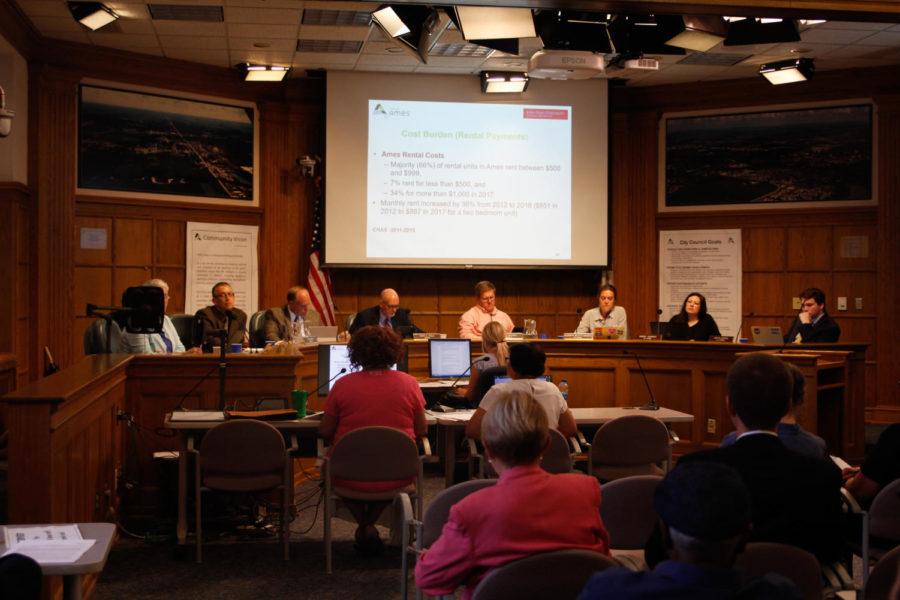Where do 15,000 people go? City council discusses future land use policies
Ames City Council members conduct business at their meeting June 18. City Council elections took place on Tuesday, where polling was open for the Ward 2, Ward 4 and at-large representative positions.
July 17, 2019
The Ames City Council reviewed future development and land use scenarios presented by RDG Planning and Design during a workshop Tuesday.
As part of its 2040 Ames Comprehensive Plan, the city is tasked with developing a new “land use policy plan” that answers where and how an estimated 15,000 more people can settle in Ames.
Planning and Housing director Kelly Diekmann co-led Tuesday night’s discussion. Reflecting on the character of Ames, incoming demographics and generational needs — Diekmann concentrated on future demands in comparison to the reality of present-day Ames.
“One of the housing issues to wrestle with, especially when you talk about new areas that haven’t had development in fifty years … is what is really going to be desirable in twenty years.” Diekmann said. “[Currently] our zoning ordinance wants about 80% single family and about 20% everything else.”
RDG Planning and Design presented four geographically distinct areas for growth to the council — primarily existing outside current city limits.
Each growth scenario addressed market forces, transportation and traffic models, accessibility to public safety resources and connectivity to regional infrastructure.
Historically, the growth of Ames revolved around the railroads, which provided an early means for delivering crops to market.
Near the end of World War II — and through the 1980s — population surged from the growth and investment into Iowa State University’s laboratories. In the 1990s — the presence of Interstate 35, and the emergence of major employment centers alongside it — contributed to even more population growth.
Today, with the levelling off of student enrollment, the estimated 15,000 people coming to Ames are predicted to derive from a single-family, millennial demographic. However, despite the estimation of an increase in single-family residents, traditional zoning practices are changing.
“Increasingly, the way that [Americans] have been used to developing, has been unaffordable to many households.” Marty Shukert, principal designer of RDG, said. “Now we’ve got pressure in various parts of the country … that are trying to eliminate exclusive single-family zoning.”
City staff is convinced that millennial cohorts are looking for amenities one would find in mixed-density neighborhoods. Resources like playgrounds, community centers, libraries, schools, and recreation opportunities are demanded without going too far from the home.
“Yes, people are moving out to suburbs again,” Diakmann said. “But it’s not the suburbs of the 70s and 80s. They [millennials] want to go to suburbs that offer the amenity package, not just traditional homes.”
A common concern among the council was the possibility for infill settlement.
Infill, or land recycling, refers to development that occurs on previously developed land.
“It is not out of the question that of the 15,000, that maybe 20 to 25% could be accommodated in infill areas.” Shukert said. “But we don’t know that for sure until we test it.”
While land recycling provides an obvious ecological advantage, 2nd Ward Representative, Tim Gartin, hesitated at its potential to displace current residents.
“I have been wrestling with the subject of infill, specifically when it crosses into the area of gentrification,” Gartin said. “Affordable housing is one of our priorities … and if we don’t consider the human aspect of this, I think we will be doing a terrible disservice to the people who are counting on us to get this right.”
In response, Diakmann asked the council to keep this topic at the forefront when they come back in the fall to discuss housing and land use policies.
At-Large City Council Representative, Bronwyn Beatty-Hansen, inquired how future land use policies will adapt to, or mitigate, the ongoing climate crisis.
“As we see increased flooding, increased drought, heat, cold, storms — was the concept of resiliency used when you were evaluating any one of these [growth scenario] areas?” Beatty-Hansen asked.
In response, city staff believed these kind of issues were not ready to be evaluated at this step in the planning process.
Towards the end of August, RDG will provide an online design studio with the proposed growth scenario areas. The online studio will allow for public comment and input. The date of availability has not yet been determined. Along with the interactive design studio, the city will be launching an awareness campaign to collect community-specific input on possible development plans.
To access Tuesday night’s workshop presentation, visit the following link: https://www.cityofames.org/home/showdocument?id=51627

















